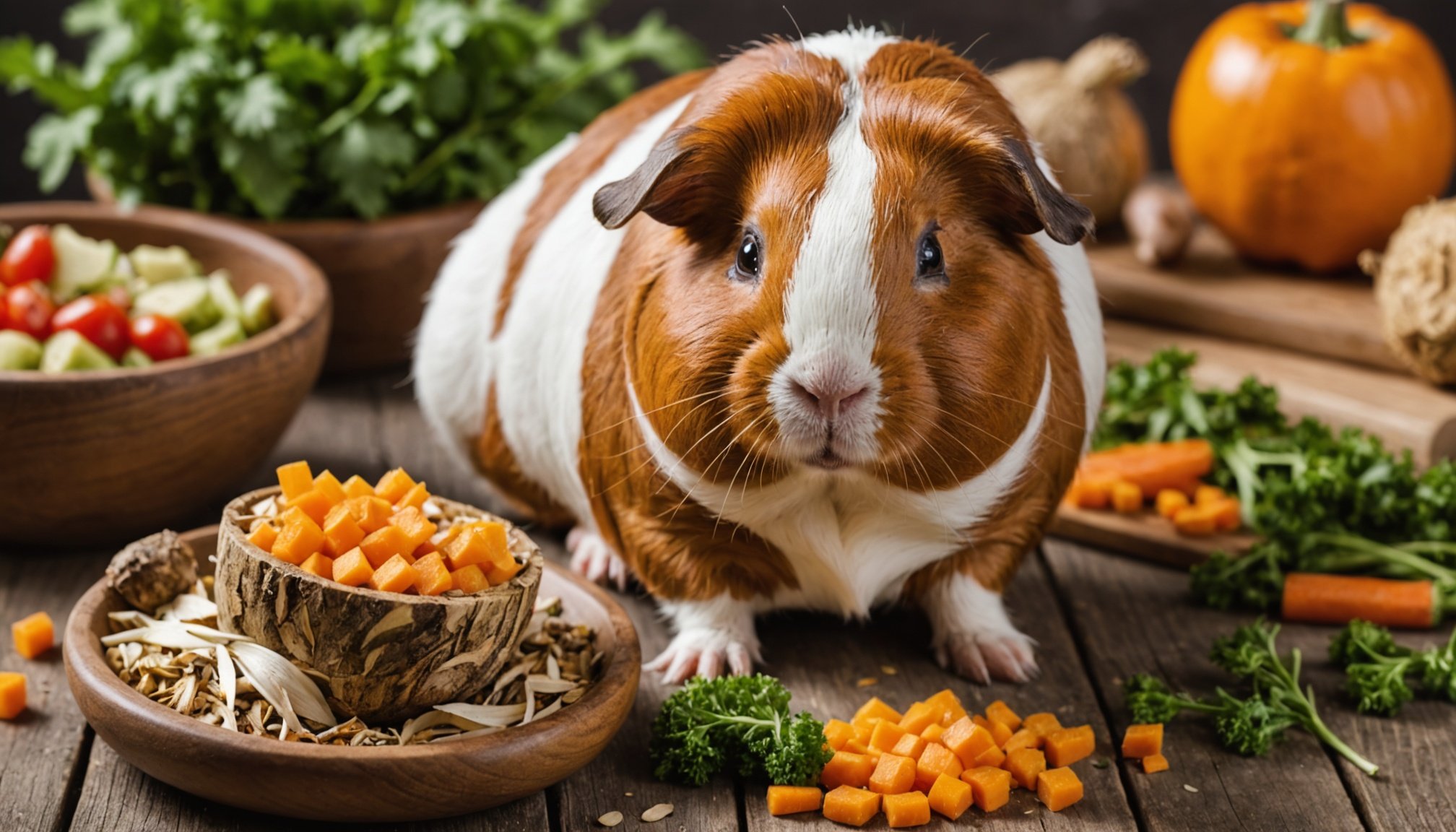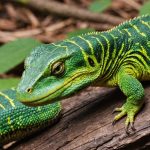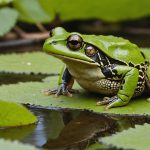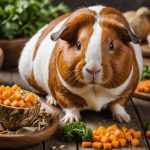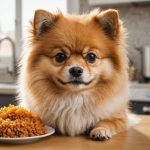Understanding the Nutritional Needs of Guinea Pigs
Ensuring that guinea pigs receive proper nutrition is crucial for their health and well-being. Among the nutritional requirements, Vitamin C is of paramount importance. Unlike some animals, guinea pigs cannot synthesize Vitamin C internally, making it an essential nutrient in their diet. A deficiency can lead to severe health issues, such as scurvy, which manifests through symptoms like weakness and swollen joints.
Fiber also plays a vital role in maintaining digestive health. A high-fibre diet helps in preventing gastrointestinal issues and supports healthy bacterial flora in the gut. Hay is an excellent source of fiber and should always be available to guinea pigs, along with fresh water.
In the same genre : Exploring the special health challenges of scottish fold cats and their unique ear structure
A balanced proportion of carbohydrates and proteins should also be part of a guinea pig’s diet. Carbohydrates provide the necessary energy, while proteins are essential for growth and repair of tissues. However, it’s crucial to maintain these proportions carefully, as excessive carbohydrates can lead to obesity, and protein overload can strain the guinea pig’s kidneys. By paying attention to these dietary basics, owners can help their guinea pigs thrive healthily in their environment.
Recommended Vegetables for a Vegetarian Diet
Introducing a variety of guinea pig-friendly veggies is essential for a balanced diet. Safe vegetables include options like bell peppers and leafy greens such as kale and spinach. These veggies are not only rich in necessary nutrients but are also loved by guinea pigs, satisfying their nutritional requirements.
Additional reading : Spotting stress in british reptiles: key indicators and proven relief techniques
Keeping seasonal availability in mind while selecting vegetables is crucial. Seasonal vegetables are fresher and more nutritious, providing essential benefits for your pet. In winter, root vegetables like carrots can be included, while summer offers fresh tomatoes and cucumber.
When introducing new vegetables, it’s essential to do so gradually. This method helps prevent digestive upset and allows guinea pigs to adapt seamlessly. Begin with a small portion of the new vegetable mixed with their regular food and monitor their reaction. If there are no signs of distress, slowly increase the portion.
By curating a diverse veggie menu for guinea pigs, owners can ensure their pets receive all the necessary nutrients while keeping their meals exciting and palatable. Remember, each guinea pig is unique, so observing their preferences and reactions is key to maintaining a healthy diet.
Portion Sizes and Feeding Frequency
Balancing portion sizes and feeding frequency is crucial for maintaining a healthy guinea pig diet. Feeding guidelines suggest that guinea pigs should have continuous access to hay, which forms the bulk of their diet. Fresh vegetables should be given once or twice daily, approximately one cup per guinea pig. This helps ensure they receive the necessary variety of essential nutrients.
Portion control becomes particularly important when managing pellets and treats. Pellets should be limited to about 1/8 cup per day, providing additional vitamins without leading to excessive calorie intake. It’s important to monitor their weight and health regularly to adjust portions as needed.
Guinea pigs’ feeding schedules should be consistent, with meals provided at the same times each day. Young or highly active guinea pigs may require slightly larger portions to support growth and energy needs.
Age and activity level also dictate how often to feed. Younger guinea pigs might need more frequent meals to support their developing bodies. By adhering to structured feeding schedules and controlled portion sizes, owners can optimise their guinea pigs’ health and prevent obesity or nutrient deficiencies.
Common Dietary Pitfalls to Avoid
Ensuring a balanced diet for guinea pigs involves understanding and avoiding common dietary mistakes. Foods high in sugar and fats, like processed snacks or chocolate, should be omitted as they can lead to obesity and other health issues. Recognizable symptoms of dietary imbalances include sudden weight changes, lethargy, and digestive problems. Monitoring these signs ensures timely adjustments and maintains your guinea pig’s health.
A poor diet can have significant impacts, potentially leading to severe conditions such as dental issues or vitamin deficiencies. For instance, a lack of adequate Vitamin C can result in scurvy. Recognizing the root of these problems often necessitates a thorough examination of the diet. Avoiding these pitfalls requires vigilance and adherence to appropriate feeding practices.
To support their well-being, provide a consistent and nutritionally balanced diet. Always ensure plenty of fresh water and quality hay is available, promoting a healthy digestive system. If in doubt, consulting with a veterinarian for dietary advice can be beneficial in offering tailored solutions and adjustments based on your guinea pig’s specific needs. Their guidance can prevent long-term health risks and improve quality of life.
Tips for Transitioning to a Vegetarian Diet
Understanding the process of transitioning your guinea pig to a vegetarian diet is crucial for success. A gradual change is of utmost importance to prevent digestive distress and ensure a smooth adaptation. Start by introducing a small portion of the new vegetarian foods into their regular diet and observe their reaction. Gradually increase the amount over a week or two until your guinea pig is accustomed to the new diet.
Signs of successful adaptation include stable weight, active behaviour, and consistent stool quality. If your guinea pig shows signs of discomfort like bloating or a loss of appetite, it may indicate difficulty adapting to the new diet. In such cases, dial back the changes, giving more time for adjustment.
Common challenges during this transition period can include reluctance to accept new foods or over-reliance on specific newly introduced items. Patience and perseverance are critical, as every guinea pig’s response can vary. Ensure you’re offering a balanced mix of essential nutrients to support their health throughout the transition. Consulting with a veterinarian can provide additional guidance tailored to your guinea pig’s specific needs.
Managing Potential Health Issues Related to Diet
Understanding the potential health concerns associated with a guinea pig’s diet is critical for preventive care. Dietary impacts may not be immediately apparent, but neglecting their nutritional requirements can lead to serious health conditions. Key problems include scurvy from Vitamin C deficiency, obesity due to excess carbohydrates, and dental issues from insufficient fiber intake.
Recognizing these dietary-related health problems early on can prevent escalation. Symptoms like sudden weight changes, lethargy, or dental discomfort should not be ignored. These can signal imbalances that require dietary adjustments or veterinary intervention.
Preventative measures are essential in maintaining a guinea pig’s health. Consistently providing a balanced diet rich in essential nutrients, like Vitamin C and fiber, is vital. Regularly checking their weight and overall vitality helps identify concerns early, allowing for quick action.
Consult a veterinarian when issues persist despite dietary corrections. Veterinary advice can offer personalized solutions and confirm whether symptoms are truly diet-related. Their expertise ensures that guinea pigs receive the best care possible, safeguarding their health against dietary pitfalls. Follow structured feeding plans, remain vigilant and employ veterinary guidance when needed for optimal health.
Expert Advice and FAQ Section
For guinea pig owners, understanding the nutritional requirements and addressing dietary concerns is essential. Here, we’ll explore some common questions and provide expert tips to ease your pet’s care journey.
How important is Vitamin C?
Vitamin C is crucial for guinea pigs due to their inability to synthesize it. A deficiency can result in scurvy, causing symptoms like lethargy and swollen joints. Ensure their diet includes fruits and veggies rich in this nutrient, such as bell peppers and kale.
What to do if my guinea pig won’t eat new vegetables?
Transition gradually, mixing new veggies with familiar foods. Persistence and patience are key. If refusal persists, review with a vet to ensure no underlying health issues.
Can young or active guinea pigs have the same diet as older ones?
Adjust portions based on activity level and age. Younger or more active guinea pigs may need extra essential nutrients for growth and energy.
For detailed dietary adjustments and personal guidance, consult with a veterinary expert. Continuous learning and adaptation to your guinea pig’s needs fosters a healthy and happy pet.
Visual Aids and Recipes
Enhancing your guinea pig’s diet can be enjoyable with recipes for guinea pigs that are both nutritious and satisfying. Here, we’ll explore fun and easy ways to ensure your pet’s meals are healthy.
Sample Recipes for Homemade Treats
Creating nutritious snacks at home can be simple. Consider making a Carrot and Bell Pepper Delight: finely chop carrots and bell peppers, mix them with a small amount of hay, and serve fresh. This recipe not only incorporates guinea pig-friendly veggies but also provides a delightful treat packed with essential nutrients.
Feeding Diagrams for Portion Sizes
Visual guides can assist in maintaining proper portion control. A diagram outlining correct proportions of hay, vegetables, and pellets helps ensure balanced feeding. This ensures your guinea pig receives the nutritional requirements needed for optimal health.
Visual Guides to Healthy Food Options
Understanding which foods are safe is crucial. Create a visual guide displaying safe fruits and vegetables like kale and cucumbers. This can serve as a handy reference for incorporating variety into your guinea pig’s diet.
Leveraging these visual aids and recipes can make feeding more organized and fun, supporting the well-being of your furry friend.

